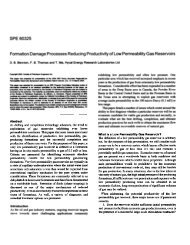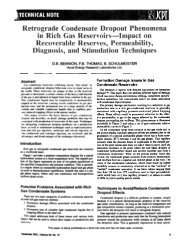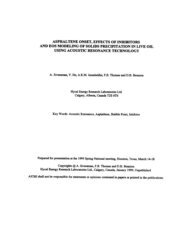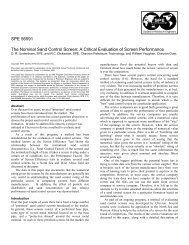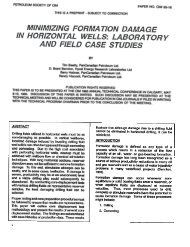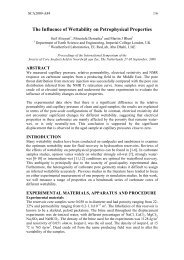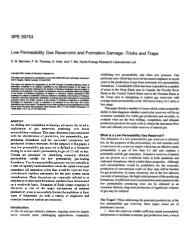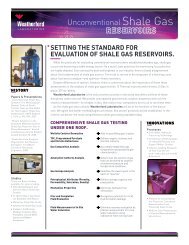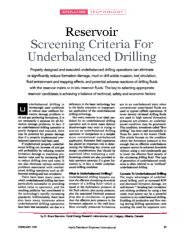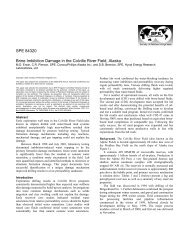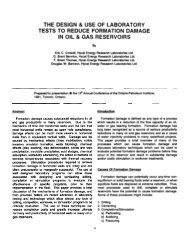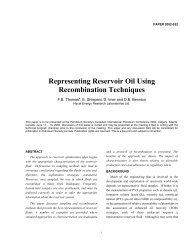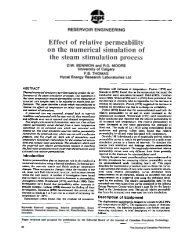Permeability and Relative Permeability Measurements at Reservoir ...
Permeability and Relative Permeability Measurements at Reservoir ...
Permeability and Relative Permeability Measurements at Reservoir ...
Create successful ePaper yourself
Turn your PDF publications into a flip-book with our unique Google optimized e-Paper software.
1<br />
SPE Paper #: 106995<br />
<strong>Permeability</strong> <strong>and</strong> <strong>Rel<strong>at</strong>ive</strong> <strong>Permeability</strong> <strong>Measurements</strong> <strong>at</strong> <strong>Reservoir</strong><br />
Conditions for CO 2 -W<strong>at</strong>er Systems in Ultra Low <strong>Permeability</strong> Confining<br />
Caprocks<br />
D. Brant Bennion, Hycal Energy Research Labor<strong>at</strong>ories Ltd., Calgary, AB, Canada, <strong>and</strong><br />
Stefan Bachu, Alberta Energy <strong>and</strong> Utilities Board, Edmonton, AB, Canada<br />
Copyright 2007, Society of Petroleum Engineers<br />
This paper was prepared for present<strong>at</strong>ion <strong>at</strong> the SPE Europec/EAGE Annual Conference <strong>and</strong><br />
Exhibition held in London, United Kingdom, 11–14 June 2007.<br />
This paper was selected for present<strong>at</strong>ion by an SPE Program Committee following review of<br />
inform<strong>at</strong>ion contained in an abstract submitted by the author(s). Contents of the paper, as<br />
presented, have not been reviewed by the Society of Petroleum Engineers <strong>and</strong> are subject to<br />
correction by the author(s). The m<strong>at</strong>erial, as presented, does not necessarily reflect any<br />
position of the Society of Petroleum Engineers, its officers, or members. Papers presented <strong>at</strong><br />
SPE meetings are subject to public<strong>at</strong>ion review by Editorial Committees of the Society of<br />
Petroleum Engineers. Electronic reproduction, distribution, or storage of any part of this paper<br />
for commercial purposes without the written consent of the Society of Petroleum Engineers is<br />
prohibited. Permission to reproduce in print is restricted to an abstract of not more than<br />
300 words; illustr<strong>at</strong>ions may not be copied. The abstract must contain conspicuous<br />
acknowledgment of where <strong>and</strong> by whom the paper was presented. Write Librarian, SPE, P.O.<br />
Box 833836, Richardson, Texas 75083-3836 U.S.A., fax 01-972-952-9435.<br />
Abstract<br />
Carbon dioxide has been successfully used in more than 80<br />
enhanced oil recovery (EOR) oper<strong>at</strong>ions in North America,<br />
<strong>and</strong> the number of such oper<strong>at</strong>ions may increase significantly<br />
around the world if CO 2 becomes available <strong>at</strong> reasonable<br />
costs. On the other h<strong>and</strong>, geological storage in deep saline<br />
aquifers <strong>and</strong> hydrocarbon reservoirs of large amounts of CO 2 ,<br />
captured from large st<strong>at</strong>ionary sources is one method th<strong>at</strong> is<br />
under consider<strong>at</strong>ion for reducing greenhouse gas emissions<br />
into the <strong>at</strong>mosphere on a worldwide basis. In both cases of<br />
CO 2 -EOR <strong>and</strong> CO 2 capture <strong>and</strong> geological storage (CCGS),<br />
the containment of CO 2 within the injection unit <strong>and</strong> leakage<br />
avoidance are essential. Effective CO 2 containment is<br />
achieved by the overlying tight caprock th<strong>at</strong> is initially highly<br />
s<strong>at</strong>ur<strong>at</strong>ed with form<strong>at</strong>ion brine, which prevents CO 2 migr<strong>at</strong>ion<br />
into uphole intervals <strong>and</strong> potentially into shallow freshw<strong>at</strong>er<br />
aquifers <strong>and</strong> ultim<strong>at</strong>ely to the <strong>at</strong>mosphere. The confining<br />
properties of the caprock are due to its very low permeability<br />
<strong>and</strong> to rel<strong>at</strong>ive permeability <strong>and</strong> capillary pressure effects th<strong>at</strong><br />
prevent the penetr<strong>at</strong>ion of CO 2 into, <strong>and</strong> significant flow<br />
through the caprock. Essential to the assessment of CO 2 -EOR<br />
<strong>and</strong> CCGS oper<strong>at</strong>ions, including numerical simul<strong>at</strong>ion, is<br />
knowledge about the caprock permeability to brine <strong>and</strong> CO 2 .<br />
This paper presents results of detailed measurements <strong>at</strong> full<br />
reservoir conditions for permeability to w<strong>at</strong>er, primary<br />
drainage <strong>and</strong> secondary imbibition permeability, rel<strong>at</strong>ive<br />
permeability <strong>and</strong> trapped s<strong>at</strong>ur<strong>at</strong>ion of supercritical, densephase<br />
CO 2 <strong>and</strong> brine for three different, regionally-extensive<br />
low permeability form<strong>at</strong>ions in the Alberta basin, Canada.<br />
These form<strong>at</strong>ions include Devonian <strong>and</strong> Cretaceous shales <strong>and</strong><br />
a Devonian anhydrite whose measured rel<strong>at</strong>ive permeabilities<br />
were found to be in the nano to pico Darcy range.<br />
The methodology used in the test program <strong>and</strong> the results can<br />
be extended to the evalu<strong>at</strong>ion of other sealing caprocks for<br />
other prospective CO 2 -EOR or CCGS oper<strong>at</strong>ions around the<br />
world.<br />
Introduction<br />
Carbon dioxide from n<strong>at</strong>ural CO 2 reservoirs is used for<br />
enhanced oil recovery (CO 2 -EOR) <strong>at</strong> more than 70 oper<strong>at</strong>ions<br />
in the Permian Basin in west Texas in the United St<strong>at</strong>es 1 .<br />
Other CO 2 -EOR oper<strong>at</strong>ions in the U.S. <strong>and</strong> around the world<br />
use CO 2 from anthropogenic sources such as gas plants <strong>and</strong><br />
petrochemical <strong>and</strong> fertilizer plants. However, the number of<br />
these CO 2 -EOR oper<strong>at</strong>ions is much smaller due to the high<br />
cost of CO 2 capture from industrial sources. On the other<br />
h<strong>and</strong>, CO 2 capture <strong>and</strong> geological storage (CCGS) is<br />
considered to be a major component of clim<strong>at</strong>e change<br />
mitig<strong>at</strong>ion str<strong>at</strong>egies 2 , <strong>and</strong>, although deep saline aquifers have<br />
the largest storage capacity <strong>and</strong> widest distribution, oil<br />
reservoirs are the most likely to be used preferentially for<br />
CCGS because of the positive economic potential for<br />
increased oil production through CO 2 -EOR schemes 3,4 . Thus,<br />
the use of CO 2 in CO 2 -EOR oper<strong>at</strong>ions <strong>and</strong> the storage of CO 2<br />
in deep saline aquifers are foreseen to increase in the next<br />
decades. In both cases it is essential th<strong>at</strong> the caprock, which is<br />
s<strong>at</strong>ur<strong>at</strong>ed with form<strong>at</strong>ion w<strong>at</strong>er, does not allow the leakage of<br />
CO 2 from the injection reservoir or aquifer into overlying<br />
str<strong>at</strong>a <strong>and</strong> possibly into shallow groundw<strong>at</strong>er resources or even<br />
to the surface. If the caprock is not n<strong>at</strong>urally fractured, then<br />
the necessary condition to avoid CO 2 leakage is to maintain<br />
the injection pressure below the capillary entry pressure or the<br />
rock fracturing pressure, whichever is lower. Even if the CO 2<br />
pressure is higher than the capillary entry pressure (but lower<br />
than the rock fracturing pressure), if the absolute <strong>and</strong> rel<strong>at</strong>ive<br />
permeabilities of the caprock are exceedingly low, then CO 2<br />
may flow through the caprock on a geological time scale, in<br />
which case, from oper<strong>at</strong>ional <strong>and</strong> CO 2 -storage points of view<br />
it may not be significant. Thus, it is very important to know<br />
the CO 2 -brine displacement characteristics of low<br />
permeability rocks, such as shale <strong>and</strong> anhydrite, which<br />
constitute the confining caprock of hydrocarbon reservoirs <strong>and</strong><br />
deep saline aquifers. Yet very few d<strong>at</strong>a are available about the<br />
displacement behavior of CO 2 -brine systems in such low<br />
permeability media, as most of the research effort to d<strong>at</strong>e has<br />
focused on CO 2 -oil systems in higher quality reservoir rocks.
106995 2<br />
To cover this gap in d<strong>at</strong>a <strong>and</strong> knowledge, the authors<br />
commenced in 2004 an experimental program on core plugs<br />
taken from rocks <strong>at</strong> several loc<strong>at</strong>ions in the Alberta basin,<br />
Canada. The rock samples were collected from oil reservoirs<br />
where oil producers started CO 2 -EOR pilot oper<strong>at</strong>ions using<br />
CO 2 or acid gas produced <strong>at</strong> nearby gas plants, <strong>and</strong> from deep<br />
saline aquifers th<strong>at</strong> may be used in the future for CO 2 storage.<br />
Interfacial tension of CO 2 -brine systems <strong>at</strong> reservoir<br />
conditions, capillary pressure <strong>and</strong> rel<strong>at</strong>ive permeability to CO 2<br />
<strong>and</strong> H 2 S for carbon<strong>at</strong>e <strong>and</strong> s<strong>and</strong>stone rocks were reported<br />
previously 5-8 . This paper presents the results of similar tests<br />
conducted on well-compacted, low-permeability shales <strong>and</strong><br />
anhydrite th<strong>at</strong> constitute the caprock <strong>at</strong> these loc<strong>at</strong>ions, namely<br />
the Middle Devonian Muskeg Form<strong>at</strong>ion anhydrite in<br />
northwestern Alberta (well 5-2-116-6 W6M) <strong>and</strong> two<br />
shales/siltstones from central Alberta, the Upper Devonian<br />
Calmar Form<strong>at</strong>ion (well 7-3-52-27 W4M) <strong>and</strong> the Upper<br />
Cretaceous Colorado Group (well 7-11-48-9 W5M). The<br />
specific details of the equipment <strong>and</strong> procedures used to<br />
conduct the tests <strong>and</strong> measurements have been presented by<br />
the authors in previous papers 5,6 <strong>and</strong> the interested reader is<br />
directed to these papers. Because pore-size <strong>and</strong> capillary<br />
pressure measurements are routine, only the procedure for the<br />
rel<strong>at</strong>ive-permeability tests will be presented here briefly.<br />
1. Mount test sample of core (3.81 cm OD core plug<br />
drilled using inert 10% KCl brine from vertical full<br />
diameter core sections in the vertical direction so th<strong>at</strong><br />
flow will be parallel to n<strong>at</strong>ural bedding planes).<br />
2. Evacu<strong>at</strong>e sample to remove all trapped gas.<br />
3. Apply net reservoir overburden pressure.<br />
4. Pressure-s<strong>at</strong>ur<strong>at</strong>e sample 100% with form<strong>at</strong>ion brine.<br />
5. Increase pore pressure to desired reservoir value<br />
while maintaining net overburden pressure.<br />
6. He<strong>at</strong> to reservoir temper<strong>at</strong>ure while maintaining pore<br />
pressure <strong>and</strong> net overburden pressure.<br />
7. Pressure-s<strong>at</strong>ur<strong>at</strong>e form<strong>at</strong>ion brine with CO 2 <strong>at</strong><br />
oper<strong>at</strong>ing temper<strong>at</strong>ure <strong>and</strong> pore pressure.<br />
8. S<strong>at</strong>ur<strong>at</strong>e CO 2 with w<strong>at</strong>er vapor <strong>at</strong> oper<strong>at</strong>ing<br />
temper<strong>at</strong>ure <strong>and</strong> pressure.<br />
9. Displace degassed form<strong>at</strong>ion brine with live<br />
form<strong>at</strong>ion brine (s<strong>at</strong>ur<strong>at</strong>ed with CO 2 gas) <strong>and</strong><br />
measure baseline absolute permeability to brine.<br />
10. Conduct an unsteady-st<strong>at</strong>e displacement with<br />
supercritical-phase w<strong>at</strong>er-vapor s<strong>at</strong>ur<strong>at</strong>ed CO 2<br />
(primary drainage test) in the w<strong>at</strong>er s<strong>at</strong>ur<strong>at</strong>ed core.<br />
The core is oriented vertically <strong>and</strong> this test is<br />
conducted in a base up fashion to simul<strong>at</strong>e the flow<br />
direction th<strong>at</strong> would be present in the reservoir with<br />
CO 2 invading from a sequestr<strong>at</strong>ion zone below the<br />
caprock.<br />
11. Measure final irreducible w<strong>at</strong>er s<strong>at</strong>ur<strong>at</strong>ion <strong>and</strong><br />
maximum CO 2 s<strong>at</strong>ur<strong>at</strong>ion <strong>and</strong> endpoint permeability<br />
<strong>and</strong> rel<strong>at</strong>ive permeability to CO 2 .<br />
12. Conduct a primary imbibition test by switching the<br />
injection fluid to CO 2 -s<strong>at</strong>ur<strong>at</strong>ed form<strong>at</strong>ion brine (top<br />
down displacement). Displace the sample with brine<br />
to an immobile CO 2 s<strong>at</strong>ur<strong>at</strong>ion level <strong>and</strong> record<br />
endpoint permeability <strong>and</strong> rel<strong>at</strong>ive permeability to<br />
CO 2 .<br />
13. Using a computer history-m<strong>at</strong>ching method 9 ,<br />
gener<strong>at</strong>e the CO 2 <strong>and</strong> brine rel<strong>at</strong>ive permeability<br />
curves for the primary drainage <strong>and</strong> imbibition<br />
displacement tests for each sample.<br />
Results specific to the work presented here include highpressure<br />
air-mercury capillary pressure measurements,<br />
interfacial tension (IFT) measurements <strong>at</strong> reservoir conditions,<br />
<strong>and</strong> rel<strong>at</strong>ive-permeability displacement characteristics for both<br />
drainage <strong>and</strong> imbibition cycles.<br />
Results <strong>and</strong> Discussion<br />
Core samples from the Upper Devonian Calmar Form<strong>at</strong>ion,<br />
Cretaceous Colorado Group <strong>and</strong> the Middle Devonian Muskeg<br />
Form<strong>at</strong>ion were obtained by drilling 3.81 cm OD plugs from<br />
parent sections of vertical full diameter core from the previous<br />
well loc<strong>at</strong>ions. The rel<strong>at</strong>ive permeability measurements for<br />
both the drainage <strong>and</strong> imbibition testing with CO 2 were<br />
conducted on the same core plug to elimin<strong>at</strong>e possible effects<br />
of various pore distributions <strong>and</strong> rock characteristics on<br />
rel<strong>at</strong>ive permeability <strong>and</strong> irreducible s<strong>at</strong>ur<strong>at</strong>ions. The offcut<br />
end sections from each test plug (removed when the sample<br />
was drilled from the parent full diameter core to obtain a<br />
perfect right cylinder) were subjected to high pressure (60,000<br />
psig) mercury injection capillary pressure testing. These end<br />
cut sections represented the best approxim<strong>at</strong>ion to the actual<br />
test samples, being removed directly from the ends of the<br />
tested samples themselves. The plug samples were drilled in a<br />
vertical orient<strong>at</strong>ion from vertical full diameter core so th<strong>at</strong> the<br />
permeability measurements would be along the vertical axis<br />
(perpendicular to n<strong>at</strong>ural bedding planes) to mimic the<br />
direction of potential fluid penetr<strong>at</strong>ion in the reservoir<br />
caprock. The characteristics <strong>and</strong> in-situ conditions of the core<br />
plugs used in this work are presented in Table 1. This includes<br />
the test conditions of temper<strong>at</strong>ure <strong>and</strong> pressure, w<strong>at</strong>er<br />
composition <strong>and</strong> CO 2 -brine interfacial tension. The test<br />
conditions presented were selected chosen as represent<strong>at</strong>ive of<br />
the particular caprock from which they were sampled.<br />
Figure 1 provides compar<strong>at</strong>ive plots of the gener<strong>at</strong>ed pore size<br />
distributions of the tested Calmar Fm. <strong>and</strong> Colorado Gp. shale<br />
samples. The CO 2 -brine capillary pressure curves <strong>at</strong> reservoir<br />
conditions (converted from the measured air-mercury capillary<br />
pressure d<strong>at</strong>a) for both the Calmar <strong>and</strong> Colorado shales are<br />
shown in Figure 2. The Colorado Gp. shale superficially<br />
appears to have slightly better quality on the pore size<br />
distribution curve than the Calmar Fm. shale, but this is due to<br />
artifacts associ<strong>at</strong>ed with surface invasion of small dissolution<br />
pores on the surface of the Colorado Gp. shale sample m<strong>at</strong>rix.<br />
If these effects are excluded, both samples consist of 100%<br />
microporosity. The Muskeg Fm. anhydrite porosity <strong>and</strong><br />
permeability are extremely low: measured porosity on the<br />
m<strong>at</strong>rix was less than 0.5% <strong>and</strong> unconfined absolute gas<br />
permeability was lower than the minimal detection limit of<br />
routine analytical equipment of 0.0001 mD. This didn’t allow<br />
any accur<strong>at</strong>e capillary pressure measurements to be conducted<br />
(virtually no measurable pore volume was available for any<br />
mercury intrusion to occur in), hence graphical capillary
106995 3<br />
pressure <strong>and</strong> pore size distribution d<strong>at</strong>a are not presented for<br />
this rock type. The capillary pressure curves <strong>and</strong> pore size d<strong>at</strong>a<br />
indic<strong>at</strong>e ultra fine grained m<strong>at</strong>rix with 100% microporosity<br />
<strong>and</strong> with average pore thro<strong>at</strong> diameters in the
106995 4<br />
differences in the rel<strong>at</strong>ive permeability characteristics, with<br />
significantly higher trapped w<strong>at</strong>er s<strong>at</strong>ur<strong>at</strong>ions to CO 2<br />
displacement <strong>and</strong> very severe hysteresis effects between the<br />
drainage <strong>and</strong> imbibition displacements. These characteristics<br />
are undesirable for reservoir rocks, but for sealing caprock<br />
they are very favorable in th<strong>at</strong> rocks of these grain sizes <strong>and</strong><br />
morphologies will have the ability to provide long term<br />
sealing sources <strong>and</strong> containment of injected CO 2 .<br />
9. Bennion, D.B., Thomas, F.B., Recent improvements in<br />
experimental <strong>and</strong> analytical techniques for the<br />
determin<strong>at</strong>ion of rel<strong>at</strong>ive permeability d<strong>at</strong>a from<br />
unsteady-st<strong>at</strong>e flow experiments; Paper presented <strong>at</strong> the<br />
SPE 10 th Techncial Conference <strong>and</strong> Exposition, Port of<br />
Spain, Trinidad, June 26-28, 1991<br />
References<br />
1. Moritis G., Special Report: EOR/Heavy Oil Survey; Oil<br />
<strong>and</strong> Gas Journal, v. 104, no. 17, 37-57, Apr. 17, 2006.<br />
2. Intern<strong>at</strong>ional Energy Agency, Prospects for CO 2<br />
Capture <strong>and</strong> Storage; IEA/OECD, Paris, France, 249<br />
p., 2004.<br />
3. Intergovernmental Panel on Clim<strong>at</strong>e Change, IPCC<br />
Special Report on Carbon Dioxide Capture <strong>and</strong><br />
Storage (eds. Metz, B., Davidson, O., de Coninck,<br />
H.C., Loos, M., <strong>and</strong> Mayer, L.A.), Cambridge<br />
University Press, Cambridge, U.K., <strong>and</strong> New York,<br />
NY, U.S.A., 442 p., 2005.<br />
4. Socolow, R.H., Can we bury global warming? Scientific<br />
American, v. 293, no. 1, 49-55, 2005.<br />
5. Bennion, B., <strong>and</strong> Bachu, S., <strong>Rel<strong>at</strong>ive</strong> permeability<br />
characteristics for CO 2 displacing w<strong>at</strong>er in a variety of<br />
potential sequestr<strong>at</strong>ion zones in the Western Canada<br />
Sedimentary Basin; Paper SPE 95547, 15 p., presented<br />
<strong>at</strong> the 2005 SPE Technical Conference <strong>and</strong> Exhibition,<br />
Dallas, TX, USA, October 9-12, 2005.<br />
6. Bennion, B., <strong>and</strong> Bachu, S., The impact of interfacial<br />
tension <strong>and</strong> pore size distribution/capillary pressure<br />
character on CO 2 rel<strong>at</strong>ive permeability <strong>at</strong> reservoir<br />
conditions in CO 2 -brine systems; Paper SPE 99325, 10<br />
p., presented <strong>at</strong> the SPE/DOE Fifteenth Symposium on<br />
Improved Oil Recovery, Tulsa, OK, USA, April 22-26,<br />
2004.<br />
7. Bennion, B., <strong>and</strong> Bachu, S., Supercritical CO 2 <strong>and</strong> H 2 S-<br />
brine drainage <strong>and</strong> imbibition rel<strong>at</strong>ive permeability<br />
rel<strong>at</strong>ionships for intergranular s<strong>and</strong>stone <strong>and</strong> carbon<strong>at</strong>e<br />
form<strong>at</strong>ions; Paper SPE 99326, 13 p., presented <strong>at</strong> the<br />
SPE Europec/EAGE Annual Conference <strong>and</strong><br />
Exhibition, Vienna, Austria, June 12-15, 2006.<br />
8. Bennion, B., <strong>and</strong> Bachu, S., Dependence on<br />
temper<strong>at</strong>ure, pressure <strong>and</strong> salinity of the IFT <strong>and</strong><br />
rel<strong>at</strong>ive permeability displacement characteristics of<br />
CO 2 injected in deep saline aquifers; Paper SPE<br />
102138, 9 p., presented <strong>at</strong> the 2006 SPE Technical<br />
Conference <strong>and</strong> Exhibition, San Antonio, TX, USA.,<br />
September 24-27, 2006.
5<br />
Unit Lithology Depth<br />
(m)<br />
Pressure<br />
(MPa)<br />
Temper<strong>at</strong>ure<br />
(ºC)<br />
Salinity<br />
(mg/l)<br />
IFT<br />
(mN/m)<br />
Colorado Gp. shale 1,618 20.00 43 27,100 19.8<br />
Calmar Fm. shale 1,566 12.25 43 129,700 27.6<br />
Muskeg Fm. anhydrite 1490.77 15.00 71 189,800 39.5<br />
Table 1 - Lithology <strong>and</strong> in-situ conditions for the low-permeability rock samples from the Alberta Basin, Canada, tested for rel<strong>at</strong>ive<br />
permeability <strong>and</strong> displacement characteristics of CO 2 -brine systems.<br />
Unit<br />
% Micro<br />
Porosity<br />
% Meso<br />
Porosity<br />
% Macro<br />
Porosity<br />
Median<br />
Pore Size<br />
(µm)<br />
Porosity<br />
(%)<br />
Threshold<br />
Capillary<br />
Pressure<br />
(kPa)<br />
Colorado Gp. 95.5 1.9 2.6 0.011 4.4 172<br />
Calmar Fm. 100. 0 0 0.006 3.9 72,827<br />
Table 2 - Pore <strong>and</strong> permeability characteristics of low permeability rock samples from the Alberta Basin, Canada, used in the analysis<br />
of rel<strong>at</strong>ive permeability <strong>and</strong> displacement characteristics of CO 2 -brine systems. Micro pores are pore connected by pore thro<strong>at</strong>s of less<br />
the 1 micron in diameter, meso pores by thro<strong>at</strong>s of 1-3 microns in diameter <strong>and</strong> macro pores by pore thro<strong>at</strong>s of over 3 microns in<br />
diameter.<br />
Rock Sample<br />
Initial Absolute<br />
<strong>Permeability</strong> to<br />
Brine (md)<br />
K r CO2 @ Irreducible<br />
Brine S<strong>at</strong>ur<strong>at</strong>ion<br />
S CO2 – Max<br />
fraction<br />
K r Brine @<br />
Trapped Gas<br />
S<strong>at</strong>ur<strong>at</strong>ion<br />
S CO2-Trapped -<br />
Fraction<br />
Colorado Gp. 0.0000788 0.0148 0.395 0.0024 0.349<br />
Calmar Fm. 0.00000294 0.1875 0.362 0.2823 0.256<br />
Muskeg Fm. 0.000354 0.0000828 0.185 tstm 0.180<br />
Table 3 - <strong>Rel<strong>at</strong>ive</strong> permeability <strong>and</strong> displacement characteristics for the drainage cycle in CO 2 -brine systems for low permeability rock<br />
samples from the Alberta Basin, Canada.
106995 6<br />
(a)<br />
CO 2 S<strong>at</strong>ur<strong>at</strong>ion Fraction K rg K rw<br />
0.395 0.0149 0.0000<br />
0.375 0.0131 0.0005<br />
0.356 0.0114 0.0010<br />
0.336 0.0098 0.0015<br />
0.316 0.0084 0.0020<br />
0.296 0.0071 0.0026<br />
0.277 0.0059 0.0034<br />
0.257 0.0049 0.0045<br />
0.237 0.0040 0.0065<br />
0.217 0.0032 0.0100<br />
0.198 0.0025 0.0159<br />
0.178 0.0019 0.0258<br />
0.158 0.0014 0.0417<br />
0.138 0.0010 0.0666<br />
0.119 0.0007 0.1044<br />
0.099 0.0004 0.1600<br />
0.079 0.0003 0.2401<br />
0.059 0.0001 0.3527<br />
0.040 0.0001 0.5081<br />
0.020 0.0000 0.7188<br />
0.000<br />
0.0000 1.0000<br />
(b)<br />
CO 2 S<strong>at</strong>ur<strong>at</strong>ion Fraction K rw K rg<br />
0.395 0.0000 0.0149<br />
0.393 0.0000 0.0125<br />
0.390 0.0000 0.0103<br />
0.388 0.0000 0.0085<br />
0.386 0.0000 0.0069<br />
0.384 0.0000 0.0055<br />
0.381 0.0000 0.0043<br />
0.379 0.0000 0.0034<br />
0.377 0.0000 0.0026<br />
0.374 0.0000 0.0019<br />
0.372 0.0000 0.0014<br />
0.370 0.0000 0.0010<br />
0.367 0.0000 0.0007<br />
0.365 0.0000 0.0004<br />
0.363 0.0000 0.0003<br />
0.361 0.0001 0.0002<br />
0.358 0.0001 0.0001<br />
0.356 0.0001 0.0000<br />
0.354 0.0001 0.0000<br />
0.351 0.0002 0.0000<br />
0.349 0.0002 0.0000<br />
Table 4– CO 2 -brine rel<strong>at</strong>ive permeability d<strong>at</strong>a for Colorado Gp. shale: a) primary drainage, <strong>and</strong> b) imbibition.<br />
(a)<br />
CO 2 S<strong>at</strong>ur<strong>at</strong>ion<br />
Fraction K rg K rw<br />
0.000 0.0000 1.0000<br />
0.018 0.0039 0.8803<br />
0.036 0.0095 0.7697<br />
0.054 0.0160 0.6679<br />
0.073 0.0232 0.5747<br />
0.091 0.0310 0.4897<br />
0.109 0.0393 0.4128<br />
0.127 0.0480 0.3437<br />
0.145 0.0570 0.2820<br />
0.163 0.0664 0.2276<br />
0.181 0.0762 0.1800<br />
0.199 0.0862 0.1390<br />
0.217 0.0965 0.1042<br />
0.236 0.1070 0.0752<br />
0.254 0.1178 0.0518<br />
0.272 0.1288 0.0334<br />
0.290 0.1401 0.0197<br />
0.308 0.1515 0.0101<br />
0.326 0.1632 0.0041<br />
0.344 0.1751 0.0010<br />
0.362 0.1871 0.0000<br />
0.256 0.2823 0.0000<br />
Table 5 – CO 2 -brine rel<strong>at</strong>ive permeability d<strong>at</strong>a for Calmar Fm. shale: a) primary drainage, <strong>and</strong> b) imbibition.<br />
(b)<br />
CO 2 S<strong>at</strong>ur<strong>at</strong>ion<br />
Fraction K rw K rg<br />
0.362 0.0000 0.1871<br />
0.357 0.0001 0.1672<br />
0.352 0.0003 0.1486<br />
0.346 0.0006 0.1311<br />
0.341 0.0010 0.1149<br />
0.336 0.0018 0.0998<br />
0.330 0.0031 0.0858<br />
0.325 0.0052 0.0730<br />
0.320 0.0083 0.0613<br />
0.315 0.0127 0.0507<br />
0.309 0.0189 0.0412<br />
0.304 0.0271 0.0328<br />
0.299 0.0379 0.0254<br />
0.293 0.0517 0.0190<br />
0.288 0.0691 0.0137<br />
0.283 0.0905 0.0092<br />
0.277 0.1167 0.0057<br />
0.272 0.1483 0.0031<br />
0.267 0.1859 0.0014<br />
0.261 0.2303 0.0003
106995 7<br />
CO 2 S<strong>at</strong>ur<strong>at</strong>ion<br />
Fraction Krg Krw<br />
0.185 0.0000828 0.0000000<br />
0.176 0.0000723 0.0004951<br />
0.167 0.0000626 0.0009903<br />
0.157 0.0000537 0.0014890<br />
0.148 0.0000457 0.0020040<br />
0.139 0.0000384 0.0025800<br />
0.130 0.0000320 0.0033210<br />
0.120 0.0000262 0.0044350<br />
0.111 0.0000212 0.0063010<br />
0.102 0.0000168 0.0095470<br />
0.093 0.0000131 0.0151600<br />
0.083 0.0000099 0.0245900<br />
0.074 0.0000073 0.0399400<br />
0.065 0.0000051 0.0641000<br />
0.056 0.0000034 0.1010000<br />
0.046 0.0000022 0.1557000<br />
0.037 0.0000012 0.2349000<br />
0.028 0.0000006 0.3471000<br />
0.019 0.0000002 0.5028000<br />
0.009 0.0000001 0.7152000<br />
0.000 0.0000000 1.0000000<br />
Table 6 – Primary drainage CO 2 -brine rel<strong>at</strong>ive permeability<br />
d<strong>at</strong>a for the Muskeg Fm. anhydrite (permeability is too low to<br />
gener<strong>at</strong>e imbibition d<strong>at</strong>a for this rock type).
106995 8<br />
Figure 1 – Measured pore thro<strong>at</strong>-size distribution for:<br />
a) Calmar Fm., <strong>and</strong> b) Colorado Gp. shale samples.<br />
Figure 2 –CO 2 -brine capillary pressure curves <strong>at</strong> reservoir<br />
conditions for a) Calmar Fm. <strong>and</strong> b) Colorado Gp. shales.
106995 9<br />
Figure 3 – Comparison of drainage <strong>and</strong> imbibition CO 2 -brine rel<strong>at</strong>ive permeability for Calmar Fm. shale in: a) Cartesian,<br />
<strong>and</strong> b), semi-log coordin<strong>at</strong>es.<br />
Figure 4 – Comparison of drainage <strong>and</strong> imbibition CO 2 -brine<br />
rel<strong>at</strong>ive permeability for Colorado Gp. shale, semi-log<br />
coordin<strong>at</strong>es.<br />
Figure 5 – Drainage CO 2 -brine rel<strong>at</strong>ive permeability for<br />
Muskeg Fm. anhydrite, semi-log coordin<strong>at</strong>es.



